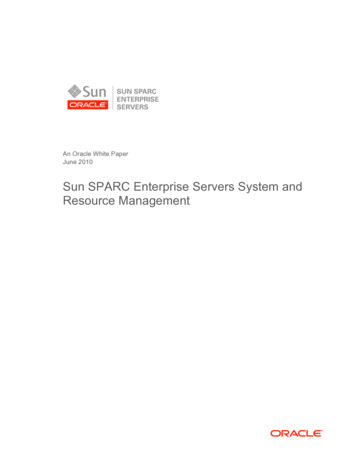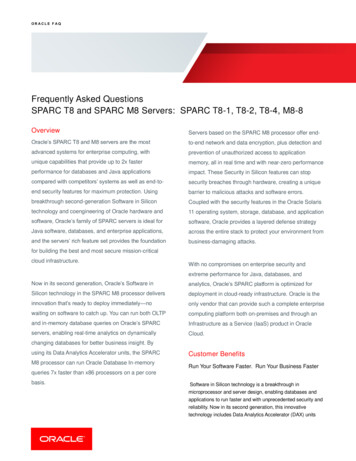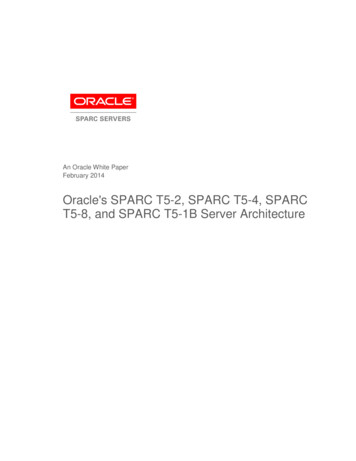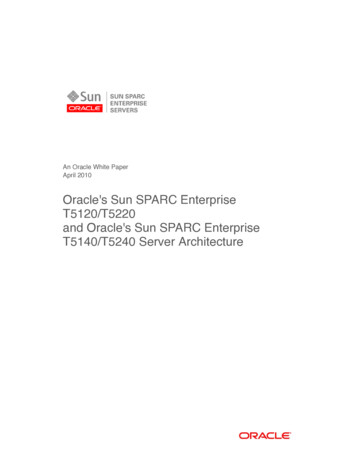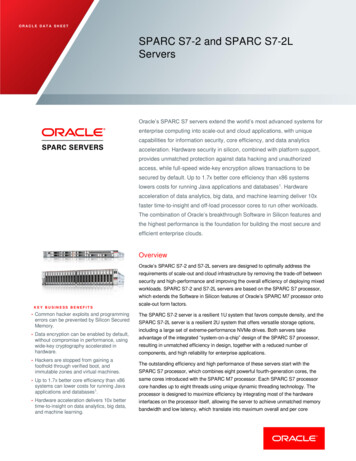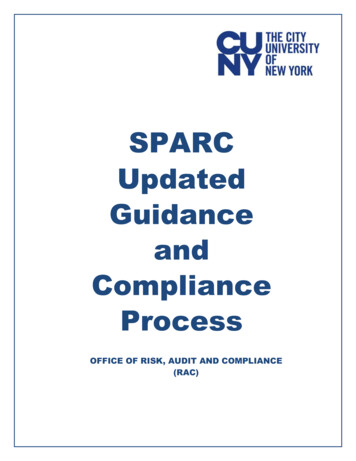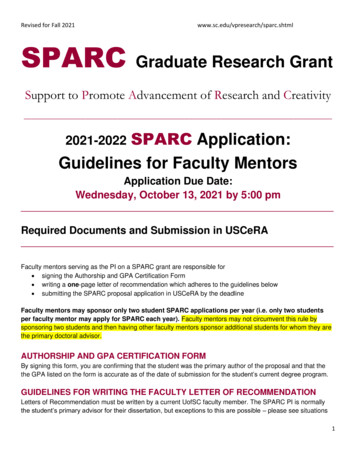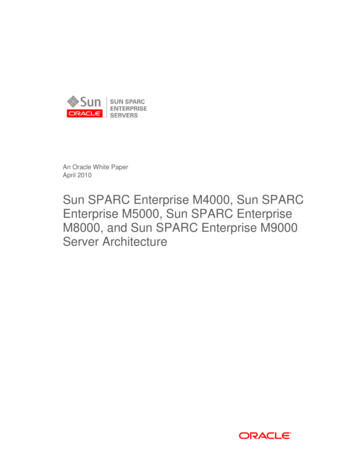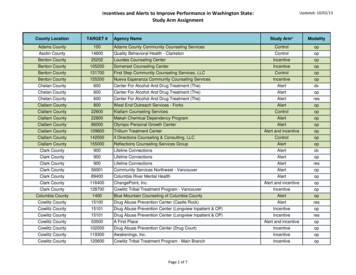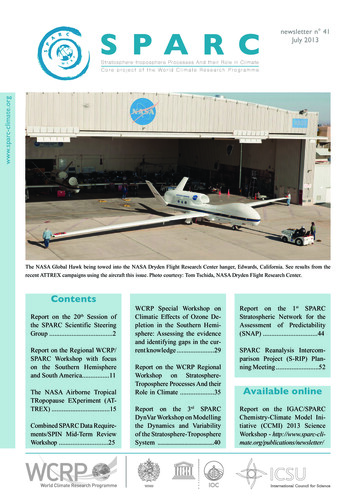
Transcription
S PA R Cnewsletter n 41July 2013Stratosphere-troposphere Processes And their Role in Climatewww.sparc-climate.orgCore project of the World Climate Research ProgrammeThe NASA Global Hawk being towed into the NASA Dryden Flight Research Center hanger, Edwards, California. See results from therecent ATTREX campaigns using the aircraft this issue. Photo courtesy: Tom Tschida, NASA Dryden Flight Research Center.ContentsReport on the 20th Session ofthe SPARC Scientific SteeringGroup .2Report on the Regional WCRP/SPARC Workshop with focuson the Southern Hemisphereand South America.11The NASA Airborne TropicalTRopopause EXperiment (ATTREX) .15Combined SPARC Data Requirements/SPIN Mid-Term ReviewWorkshop .25WCRP Special Workshop onClimatic Effects of Ozone Depletion in the Southern Hemisphere: Assessing the evidenceand identifying gaps in the current knowledge .29Report on the WCRP RegionalWorkshop on StratosphereTroposphere Processes And theirRole in Climate .35Report on the 3rd SPARCDynVar Workshop on Modellingthe Dynamics and Variabilityof the Stratosphere-TroposphereSystem .40Report on the 1st SPARCStratospheric Network for theAssessment of Predictability(SNAP) .44SPARC Reanalysis Intercomparison Project (S-RIP) Planning Meeting .52Available onlineReport on the IGAC/SPARCChemistry-Climate Model Initiative (CCMI) 2013 ScienceWorkshop - er/
Report on the 20th Session of theSPARC Scientific Steering Group27-30 November 2012, Buenos Aires, ArgentinaJohannes Staehelin1, Ted Shepherd2 , Greg Bodeker3, Joan Alexander41SPARC Office, Zurich, Switzerland, johannes.staehelin@env.ethz.ch, 2University of Reading, UK, 3Bodeker Scientific, New Zealand,4NorthWest Research Associates/CoRA, USAThe 20th Session of the SPARC SSG(Scientific Steering Group) washeld at SIGEN (Sindicatura General de la Nación) in Buenos Aires,Argentina, from 27-30 November2012, hosted by the ‘Centro de Investigaciones del Mar y la Atmósfera’, of the University of BuenosAires.Opening session and WCRP/SPARC updateGreg Bodeker (SPARC co-chair)opened the Scientific SteeringGroup (SSG) meeting by welcoming all participants, particularlythose from South America whojoined the first session, and thankedthe local organisers. A new formatfor the meeting was introduced, requiring the activity leaders to provide a short report detailing theirmain scientific achievements, anoutlook for the future, and any financial requests for the comingyear. These reports were distributed to all participants prior to themeeting, while during the meetingbrief scientific presentations werethen made in plenary and logistical aspects were discussed separately in small groups with the SSGmembers. This allowed more focuson coordination and logistical issues. The reports have now beencompiled to produce the very firstSPARC Annual Report 2012.Carolina Vera (a member of the2WCRP’s Joint Scientific Committee (JSC)) provided an update ofWCRP activities on behalf of Antonio Busalacchi (JSC Chair), whowas unable to attend the meeting.She mentioned the very successfulWCRP Open Science Conference(OSC), which took place from 2429 October 2011, in Denver, USA(http://conference2011.wcrp-climate.org). The new WCRP structure was discussed in a short JSCmeeting following the OSC, and infurther detail at the next JSC meeting, which took place from 17-20July 2012 in Beijing, China (formore details see the meeting reportin SPARC Newsletter no. 401). Under the new structure, six GrandChallenges (GCs) will play a critical role, enabling the developmentof targeted research efforts that willprovide successful results on 5-10year timescales. Two new councils have also been established, theWCRP Modelling Advisory Council (WMAC) and the WCRP DataAdvisory Council (WDAC) (see below for further details). A teleconference later during the meetingwith Antonio Busalacchi confirmedSPARC’s vital role in the WCRP’sGCs. Carolina closed by discussingthe emerging Future Earth initiative, to which the WCRP will contribute significantly. Later, she alsopresented a summary of the one anda half-day local workshop, whichtook place prior to the SSG meeting(see article later in this issue).SPARC newsletter n 41 - July 2013Ted Shepherd (SPARC co-chair)began his presentation by summarizing SPARC’s goals and organisation, and then continued by mentioning SPARC’s name change (again,see below for further details). Hefurther discussed SPARC’s role inthe new WCRP GCs. SPARC willcontribute to several GCs, including ‘Regional Climate Information’(led by the Working Group on Regional Climate), through researchfocusing on atmospheric circulationchanges, and to the GC ‘Cryospherein a Changing Climate’ (co-led byCliC, the Climate and Cryosphereproject), through the Polar ClimatePredictability Initiative (PCPI, seebelow). SPARC will also contributeto the GC ‘Science Underpinningthe Prediction and Attribution ofExtreme Events’ (led by GEWEX),as well as to the GC ‘Clouds, Circulation and Climate Sensitivity’ (ledby WGCM, see below), throughresearch focused on circulationanalyses, upper tropospheric water vapour, and sulphate aerosol microphysics. Together with GEWEX,IGAC (the International Global Atmospheric Chemistry project), andother research partners, SPARC isexpected to take a lead on /customer/6 Publications/NewsletterPDF/40 SPARCnewsletter Jan2013web.pdf
lated research in support of the GCs.Monica Rabolli made a presentation on behalf of CONAE (Comision Nacional de Activitas Espaciales, the Argentinian SpaceAgency), providing an overviewof the AQUARIUS satellite mission, a common project betweenCONAE and NASA. The mainscientific goal of this mission is toimprove understanding of the interactions between ocean circulation,the water cycle and climate. Thesatellite was launched on 10 June2011 and provides global information on sea surface salinity and soilmoisture. AQUARIUS instrumentsalso measure sea-ice concentration,rainfall rate, wind speed, water vapour, cloud liquid water contentand fires can be detected. These observations have provided detailedinformation on tropical instabilitywaves, the Amazon outflow plumeand hurricanes. Examples from recent studies showed that it was possible to identify hurricane Gordonusing AQUARIUS rain rate observations, while hurricane Sandy wasobserved using water vapour column data. Argentinian research using AQUARIUS data will focus onthe Rio de la Plata outflow plume.Jürgen Scheer presented an overview of the Network for Detectionof Mesospheric Change (NDMC:http://wdc.dlr.de/ndmc/), whichprovides a framework for international cooperation to study themesopause region (extending from80-100km altitude). The NDMCwas established in 2007 through aninitiative of the ICSU/WMO-WorldData Centre for Remote Sensing ofthe Atmosphere, which is operatedby the German Aerospace Centre.The NDMC is a global programmeaimed at identifying and quantifying atmospheric change by monitoring key parameters for the earlycharacterisation of climate signalsin the mesosphere. NDMC is focused on coordinating the study ofmesospheric variability on all timescales, as well as the coordinateddevelopment of improved observation and analysis techniquesand modelling of the mesosphere.NDMC science is currently focusedon the following topics: (1) planetary waves, (2) gravity waves, (3)vertical coupling, (4) inter-hemispheric coupling, (5) infrasound,(6) climate change signal detection,and (7) network intercomparison.Jürgen presented some results fromvarious NDMC studies and thenfinished by making proposals forcollaborations between SPARC andthe NDMC.SPARC activity reportsTed Shepherd presented the newChemistry Climate Modelling Initiative (CCMI) on behalf of VeronikaEyring. The initiative, jointly supported by IGAC and SPARC, wasdiscussed with the community andplans were approved at a workshop that took place from 21-24May 2012, in Davos, Switzerland.The specific goals of the Davosworkshop were to: (1) assess improvements in process-orientedevaluation and understanding ofChemistry Climate Models (CCMs;extending the CCMVal approach tothe troposphere), (2) identify observations for model evaluation andnew methods for improved comparability between models and observations, and (3) define communitywide simulations in support of theupcoming WMO Ozone and futureIPCC Climate Assessments, as wellas for process studies. The outcomeof the workshop is described in further detail in a recent SPARC Newsletter article2. More generally, thegoals of CCMI are to: (1) promotethe use and development of globalmodels that include chemistry anddynamics of the stratosphere andtroposphere, as well as a coupledocean, such models are expectedto become more common; (2) tocompare tropospheric, stratospheric and coupled chemistry-climatemodels with observations, as wellas with each other; and (3) to bettercoordinate stratospheric and tropospheric modelling activities and toaddress specific scientific questionsin the context of comprehensivestratosphere-troposphereresolving models including atmosphericchemistry. A CCMI website hasbeen created (http://www.pa.op.dlr.de/CCMI) and a 2nd workshopwas held in Boulder, USA, from 1416 May 2013. Veronika Eyring andJean-François Lamarque act as cochairs of the activity, and a CCMIscientific steering committee hasbeen formed.Claire Granier, a member of theIGAC Scientific Steering Committee and SPARC liaison, presenteda short overview of IGAC’s mainprojects, including CCMI, to whichIGAC is strongly committed. IGACproposed that Veronika Eyring andJean-François Lamarque are formally recognized as co-chairs ofCCMI and intends to comment onthe CCMI leadership plan to ensurethe widest possible IGAC engagement. Allen Goldstein (incomingIGAC co-chair) was also involvedin supporting the 2nd CCMI workshop. CCMI science will be vital toIGAC’s focus on air pollution andclimate, which is a theme of growing importance for IGAC. As partof the International Geosphere-Biosphere Programme (IGBP), IGACwill be integrated into the Future2Eyring et al. (2013) Overview of IGAC/SPARC Chemistry-Climate Model Initiative (CCMI) Community Simulations inSupport of Upcoming Ozone and ClimateAssessments. SPARC newsletter No. 40SPARC newsletter n 41 - July 20133
Earth initiative, but this will not affect IGAC’s commitment to CCMI.Paul Newman presented the ‘Lifetimes of Halogen Source Gases’activity. This SPARC activity is thefirst re-evaluation of the lifetimes ofozone-depleting substances (ODSs)since 1998 (WMO/UNEP OzoneAssessment, 1999) and first in-depthmodification since 1994 (Kaye etal., 19943). Results show that different approaches result in different lifetime estimates, but overallthere is good consistency, and uncertainties have been significantlyreduced, through, for example, there-evaluation of photochemicaldata. The lifetime estimates of certain species, for example CCl4 andCFC-11, have changed significantlysince the last WMO Ozone Assessment. The third draft of the reporthas been completed and reviewed,and work on the final report is inprogress. The lifetimes recommendations will be finalized in mid2013 and new ODS scenarios willbe completed for the CCMI activityafter this finalization. Results fromthis activity will also be included inthe upcoming 2014 WMO/UNEPOzone Assessment.Julie3ArblasterpresentedtheKaye, J. A., S. A. Penkett, F. M. Ormond(eds.) (1994) Report on Concentrations,Lifetimes, and Trends of CFCs, Halons, andRelated Species. NASA Reference Publication 1339, Washington, D.C.4Ermolli et al., 2013: Recent variability ofthe solar spectral irradiance and its impacton climate modelling. Atmos. Chem. Phys.,13, Paper/AquaVITWhitePaperFinal 23Oct2009 6MB.pdf6Krämer et al., 2009: Ice supersatuarationsand cirrus cloud crystal numbers. Atmos.Chem. Physics, 9, 3505-35224SOLARIS-HEPPA activity (SOLARIS: SOLAR Influences forSPARC, HEPPA: High EnergyParticle Precipitation in the Atmosphere) on behalf of Katja Matthesand Bernd Funke. She started bypresenting results from a joint studylooking at recent solar spectral irradiance variability and its impact onclimate modelling4. The main uncertainty in spectral solar irradiancelies in the 220-400nm wavelengthrange, where substantial differencesbetween different satellite measurements remain. While the number ofnumerical simulations taking intoaccount spectral solar irradiance isincreasing, comparisons of available model simulations are hamperedby slightly different experimentalsetups, motivating new coordinatedSOLARIS-HEPPA simulations. Using measurements from the SORCE(SOlar Radiation and ClimateExperiment) satellite instrumentleads to simulated atmospherictemperature responses being up tothree times larger than when usingother data. Julie also reported onthe HEPPA-II coordinated intercomparison study, which suggeststhat the proton forcing (i.e. directinfluence of solar proton events) iswell represented in the participatingmodels and should be consideredin all models. In contrast, electronforcing data constraining ionizationbelow 100km remains uncertain.Ongoing efforts are focused on constructing an observations-based energetic particle precipitation (EPP)NOy source parameterization formodels with lids below 100km. In2013, the SOLARIS-HEPPA activity aims to publish a white paper,continue the HEPPA model-measurement intercomparison study,evaluate the solar cycle signal in theCCMI hindcast simulations as wellas in satellite observations, and provide recommendations for including EPP indirect effects in low-topmodels.SPARC newsletter n 41 - July 2013Karen Rosenlof reported on theWAVAS-2 activity (WAter VapourASsessment 2), which focuses ontwo main topics: (1) super saturationand in situ measurement data quality, and (2) upper troposphere andstratosphere climatologies, trendsand radiative effects. As part of topic 1, controlled, refereed, blind intercomparisons of the principal airborne field instruments were madeusing the AIDA chamber, and strictquality checks of in-situ aircraftobservations of relative humidityshowed that many of the highestrelative humidity values (exceptat very low temperature) are questionable (AquaVIT White Paper,20095; Krämer et al., 20096). Thiswork shows that at very high relative humidities even state-of-the-artinstrumentation introduces uncertainties that are too large, and thusmany field measurements indicatingsupersaturation may not be reliable.There is therefore a strong need toimprove current field instrumentation. The shifts in aircraft measurements generally preclude their usefor trend analyses. However, comparisons with a stable satellite record may be useful for verifying ordiscounting extreme aircraft campaign anomalies. The second focusof this activity has been recently reorganised and now falls under theleadership of Gabrielle Stiller. Thistopic aims to analyse and combinelong-term satellite observations ofstratospheric water vapour for useas model boundary conditions, aswell as for model comparison. Theyare currently aiming to produce asatellite climatology using SAGEII, HALOE and Aura MLS observations. Gaps in this data set maybe filled with ACE, SAGE III andpossibly other, shorter period satellite records. Ultimately, the aimis to perform trend and variabilityanalysis on these data, and to carryout an assessment of uncertainties.An authors’ meeting is to be held in
Boulder, USA, in 2013, to finalize areview paper covering super saturation and data quality issues.Michaela Hegglin and SusannTegtmeier presented progress onthe “Data Initiative”. This activityfocuses on comparing stratosphericand upper tropospheric/lower stratospheric satellite measurementsof many important species, and iscarried out in close collaborationwith the satellite science teams. Thecomparison entails determining azonal and monthly mean climatology using all available overlapping data, and then comparing theindividual satellite records to thisclimatology. This allows a characterisation of measurements fromindividual instruments, while statistical analyses of the differencesalso provide an overall assessmentof the respective species. Michaelapresented the results of the watervapour analysis and provided anoverview of the status of the activity. The activity is hoping to finishits final report in late 2013.Johannes Staehelin presented thestatus of the SI2N initiative, whichfocuses on understanding pastchanges in the vertical distributionof ozone. The activity is supportedby SPARC, the International OzoneCommission (IO3C), IntegratedGlobal Atmospheric Chemistry Observations (IGACO-O3/UV), andthe Network for the Detection ofAtmospheric Composition Change(NDACC). A challenge for this project is to assess the consistency ofsatellite measurements suitable forderiving reliable information onozone profile changes. This is particularly difficult since chemicalozone depletion reversed during thesecond part of the 1990s as a resultof the successful implementationof the Montreal Protocol. Researchis conducted by several workinggroups focusing on improving sat-ellite observational records fromthe past decade, producing longterm merged satellite data series,data quality assessment of longterm ozonesonde records, and theanalysis of long-term ground-basedobservations (including Umkehr, lidar, microwave and FTIR observations). A final review meeting willbe held in Helsinki, Finland, in September 2013. The activity will present its final results through specialissues of three journals (AtmosphericChemistry and Physics, AtmosphericMeasurement Techniques and EarthSystem Science Data), which willbe published in time for the 2014WMO/UNEP Ozone Assessment.Dian Seidel presented an update ofthe stratospheric temperature trendsactivity. A NOAA team produceda new record of stratospheric temperatures derived from AMSU (Advanced Microwave Sounding Unit)and SSU (Stratospheric SoundingUnit) instruments. These data showremarkable differences comparedto an earlier analysis by the UKMet Office, particularly in terms ofthe evolution of stratospheric temperature between 25-45km afterthe middle of the 1990s. The agreement between stratospheric satellitetemperature records and chemistryclimate models is also rather poorfor this period. A Nature article byThompson et al.7 called into question our understanding of observedstratospheric temperature trends,which are thought to be caused bychanges in ozone, carbon dioxide,and, at lower altitudes, also by watervapour. The activity encourages thepublication of independent methodsfor merging SSU and AMSU data,and will attempt to recover tapes ofoverlapping SSU observations fromthe UK Met Office. They may alsolink with work on stratospheric reanalysis activities.Joan Alexander (SPARC co-chair,SPARC newsletter n 41 - July 2013as of 1 January 2013) presentedprogress of the SPARC gravitywaves activity. Gravity waves influence global circulation and climatethrough changes in gravity wavemomentum forces in the stratosphere and mesosphere, which canlead to changes in stratospheric andtropospheric circulation. Over thepast year global distributions, andseasonal and interannual variationsof gravity wave momentum fluxes in various global data sets andmodel estimates were analysed andcompared in a project supportedby the International Space ScienceInstitute (ISSI). Because gravitywaves are intermittent events, accurately determining gravity wavemomentum fluxes requires information regarding both the amplitude and frequency of occurrenceof wave events. Models that fullyresolve the middle atmosphere werefound to have similar gravity wavemomentum fluxes, likely becausethey require similar forces to obtainrealistic circulations. However, asimple increase in horizontal resolution is insufficient to produce realistic gravity wave fluxes. Otherfactors such as dissipation, modelnumerics, and vertical resolutionalso need to be improved. Theanalysis indicated that (1) observedfluxes decrease more rapidly withheight than parameterized fluxes;(2) waves that can be observed havelonger horizontal wavelengths andmay dissipate lower in altitude; (3)the CAM5 global model’s stratosphere acts as a “sponge” layer, andtherefore dissipation is unrealistic;and (4) even high resolution models still under-resolve importantorographic waves. The ISSI groupis preparing a new paper compar-7Thompson et al., 2012: The mystery ofrecent stratospheric temperature trends. Nature, 491, 692-69725
ing intermittency in gravity wavesin models and observations. In future, the activity will focus on gravity wave forcing on circulation using global assimilation methods,as well as regional foci on wavesource regions, including high latitude southern hemisphere winterwaves and tropical waves.Mark Baldwin began his presentation on the DynVar (Dynamical Variability) activity, on behalf of ElisaManzini, by asking several fundamental questions related to dynamical coupling of the stratosphere andtroposphere: What is the role of dynamical and radiative coupling withthe stratosphere in extended-rangetropospheric weather forecastingand in determining long-term trendsin tropospheric climate? By whatmechanisms do the stratosphere andtroposphere act as a coupled system? What will the role of the stratosphere be as climate changes? Inan attempt to answer some of thesequestions, DynVar has focusedmuch attention on the analysis of therole of the stratosphere in CMIP5output. Key results from DynVaractivities (described in Manzini etal., 20128, and Charlton-Perez etal., 20139) confirm previous projections, which indicate that by theend of the 21st century, lower stratospheric polar winds will weakenat high latitudes and strengthen atlow latitudes. Categorising modelsas high- or low-top did not revealsignificant differences in simulatedpolar winter stratospheric changes.Interestingly, the CMIP5 modelswere found to be more usefullysubdivided according to projectedwinter polar stratospheric changes,since changes in the strength of thewinter polar vortex can be an important factor for the projection ofsurface changes. In terms of meanclimate, the skill of high- and lowtop model ensembles was found tobe similar, but the skill in simulat-6ing stratospheric climate variabilityon daily, interannual and decadaltimescales was significantly betterin the high-top ensemble. This isparticularly the case in regions andseasons during which wave-drivenstratospheric dynamical variabilityis substantial. In addition, in theextra-tropical lower stratosphere,the region most critical for communicating stratospheric changes tothe troposphere, the mean climatewas almost identical between lowand high-top ensembles. The DynVar activity held its 3rd workshopin Reading, UK, from 22-24 April2013 (see report, this issue).David Jackson presented developments in the SPARC Data Assimilation (DA) activity, out of which twonew SPARC activities (SNAP andS-RIP, see below) are evolving. Theactivity held a workshop in Socorro, USA, in June 2012 (see the article in SPARC newsletter No. 4010).At the workshop, two new areas ofpotential research were proposed:(1) an intercomparison of the missing body force due to sub-grid scalegravity wave drag (which maypartly be dealt with by the GravityWave activity, see above), and (2) astudy of model vertical resolution,although this would need to be further refined to become realistic, forexample, by focusing on the impactof vertical resolution on the QBO.A study looking at the changes insurface ozone simulated by theGEOS-CHEM model when assimilating MLS and TES satellite ozoneobservations was presented. Results indicate that biases decreaseby 5-15%, although more work isrequired to understand what thedata assimilation can tell us aboutvertical mixing. At present, the interaction between the chemical dataassimilation and satellite retrievalcommunities is still rather informal,but the activity is aiming to furtherdevelop links between the two. TheSPARC newsletter n 41 - July 2013DA group will also produce a summary report on the representationof the stratosphere in numericalweather prediction models.Emerging activitiesMarkus Rex reported on the progress of the Stratospheric Sulfur andits Role in Climate (SSiRC) activity.Since the SSG meeting in Zürich, inwhich SSiRC was endorsed as anemerging SPARC activity, a whitepaper has been published, a kick-offmeeting took place, and an implementation plan has been developed.This activity will improve our understanding of the processes thatsustain the stratospheric aerosollayer (largely made up of sulphur),as well as their variability and longterm changes. SSiRC will includethe following major components: insitu aircraft and balloon measurements, ground-based remote sensing, satellite remote sensing, microphysical lab studies, process andglobal modelling, and a databasehousing all related data. Resultsfrom new research examining howsulphur is transported into the stratosphere were presented. They indicate that one of the most efficientpathways for sulphur transport tothe stratosphere may be in the tropical Western Pacific. In this region,extremely low ozone mixing ratios8Manzini et al., 2012: Stratosphere-trop-osphere coupling at inter-decadal timescales: Implications for the North AtlanticOcean. Geophys. Res. Letters, 39, DOI:10.1029/2011GL0507719Charlton-Perez et al., 2013: On the lack ofstratospheric dynamical variability in lowtop versions of the CMIP5 models. J. Geophys. Res., 118, DOI: filead-min/customer/6 Publications/Newsl e t t e r P D F / 4 0 S PA R C n e w s l e t t e rJan2013 web.pdf.
suggest very low OH levels (the socalled “OH-hole”), a feature whichis expected to slow the oxidation ofkey tropospheric species, including SO2 and its precursors, and thusmight provide a potentially efficientpathway for these species to enterthe stratosphere. Further measurements and modelling studies areneeded to confirm these results. TheSSiRC implementation plan was extensively discussed and SSiRC wasapproved as a new SPARC activity.David Jackson reported on theSNAP activity (Stratospheric Network on Assessment of Predictability), on behalf of AndrewCharlton-Perez. This activity aimsto quantify: (1) current skill in extra-tropical stratospheric forecasts,(2) the extent to which accurateforecasts contribute to improvedtropospheric predictability, and (3)the partitioning of any gains in predictability between improvementsin initial conditions and the forwardforecast. Critical questions include:Is it really stratospheric influenceor other model changes that improve tropospheric forecast skill?Is the improvement due to improvements in the modelled stratosphereor to the observations? Results arelikely model dependent, and therefore prompts the question of howgeneric are improvements? Furtherquestions include: Are stratospheretroposphere coupling effects important throughout the winter seasonor only when major stratosphericdynamical events occur? How farin advance can major stratosphericdynamical events be predicted andusefully add skill to troposphericforecasts? Which stratosphericprocesses, both resolved and unresolved, need to be simulated to gainoptimal stratospheric predictability? To address these questions, multiple model comparisons and casestudies will be needed. SNAP hasrecently formed a Steering Com-mittee, held an initial workshopfrom 24-26 April 2013 in Reading,UK (see article, this issue), and willwrite a review paper on the role ofthe stratosphere in predictability.The planned stratospheric predictability modelling experiments areexpected to start in June 2013.Continuing on, David discussed theplans of the SPARC-Reanalysis/Analysis Intercomparison Project(S-RIP), on behalf of MasatomoFujiwara. Reanalyses contain keyinformation on the time-evolvingstate of the atmosphere and arewidely used by a large community.At present, several reanalysis products exist, and S-RIP is a coordinated activity aimed at comparingthese data sets for various “key”diagnostics. The activity aims to:(1) understand the causes of differences between reanalyses; (2) usethe results to provide guidance onappropriate usage of various reanalysis products in scientific studies; (3) better coordinate with datausers, which hopefully will leadto improvements in the next generation of reanalysis products; and(4) establish a closer collaborationbetween the data users and reanalysis centres. Over the past yearS-RIP research activities have beendiscussed at several meetings, including the 2012 DA workshop(see above), and the activity held aplanning workshop from 29 Aprilto 1 May 2013 in Exeter, UK (seereport, this issue), where the finalS-RIP report structure, time schedule, analysis guidelines, and chapterlead authors were discussed. The final activity report is planned to befinished by 2015.Other PresentationsOn behalf of Scott Osprey, NealButchart and Kevin Hamilton, TedShepherd presented a proposal fora new SPARC activity focused onSPARC newsletter n 41 - July 2013modelling the Quasi-Biennial Oscillation (QBO). The QBO is directly linked to how well a model simulates circulation and transport ofchemical species throughout muchof the atmosphere. QBO variabilityis a function of model discretisation, diffusion, resolved waves, andvarious parameterization schemes(e.g. gravity waves, convection).Very few models are able to produce internally-generated QBOs,and there has been little recent progress to improve this aspect. Theproposed plan included the designof a coordinated set of numerical experiments to systematicallyexplore the effects of: (1) verticalresolution, (2) resolved waves, (3)parameteri
2 Report on the 20th Session of the SPARC Scientific Steering Group 27-30 November 2012, Buenos Aires, Argentina 1SPARC Office, Zurich, Switzerland, johannes.staehelin@env.ethz.ch, 2University of Reading, UK, 3Bodeker Scientific, New Zealand, 4 NorthWest Research Associates/CoRA, USA SPARC newsletter n 41 - July 2013 Johannes Staehelin1, Ted Shepherd 2 , Greg Bodeker3, Joan Alexander 4
